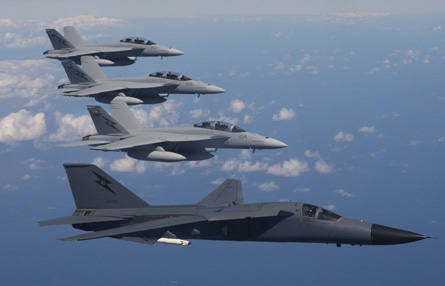The Royal Australian Air Force is on track to stand up the first Boeing F/A-18F operational squadron in December with two extra aircraft than originally planned and a new appreciation for the Super Hornet's capabilities.
A fleet of 24 F/A-18Fs will replace the RAAF's General Dynamics F-111 on an interim basis. Delays to the Lockheed Martin F-35 Joint Strike Fighter in 2004 forced the RAAF to acquire Super Hornets as a stopgap in 2006. But the F/A-18Fs are due to be retired by 2021 as the F-35 is delivered.
So far, Boeing has delivered the first five F/A-18Fs to 1 Sqn at RAAF Amberley, with as many as nine more jets arriving before initial operational capability is declared in December. The F-111 is scheduled for retirement on 2 December.
 |
|---|
© Australian Department of Defence |
Despite the Super Hornet's short-term service plan, the multi-role fighter has already surprised the RAAF leadership with its advanced capabilities.
"It's a little bit embarrassing for me," says Gp Capt Steve Roberton, commander of 82 Wing. "It is fair to say the jet has proven to be more robust and exceeded what we thought."
Roberton pointed to what he considers the aircraft's singular ability to simultaneously track air and ground targets using an array of sensors, including the Raytheon APG-79 active electronically scanned array (AESA) radar.
The RAAF intends to bolster the Super Hornet's targeting capability by integrating the joint helmet mounted cueing system (JHMCS) in both the front and back seat. The US Navy has only experimented with that configuration, and the RAAF may be first to adopt JHMCS in both seats.
With a much smaller force structure than the USN, the RAAF believes it can harness the Super Hornet's full capabilities much sooner, Roberton says. Due to training infrastructure limitations, the USN operates the AESA-equipped F/A-18E/F Block II similarly to the Block I Super Hornet and classic F/A-18C/Ds.
The RAAF, however, intends to operate the F/A-18F more like how the US Air Force flies the multi-role Boeing F-15E Strike Eagle, Roberton says.
Although the F/A-18F has impressed, RAAF officials are disappointed the Super Hornet's AESA technology remains unable to perform electronic attack missions in the X-band of the electromagnetic spectrum, Roberton says.
"There are some things the radar does which are not as far along the proposed flight plan that they have as we had hoped," he says. But "it's still better than anything we got".
The RAAF also remains committed to buy F-35s as a permanent replacement for the F-111 and classic F/A-18A/Bs in its inventory. Roberton described the F-35's potential as "phenomenal", but also voiced a note of doubt.
"I don't know how the [F-35] is going to emerge," he says. "What I do know is that the environment and the challenges that emerge in 10 years time are going to be different than what they are now. So we're speculating, I guess."
Source: Flight International
















